- Ethylgallat
- Propylgallat (E 310)
- Octylgallat (E 311)
- Dodecylgallat (E 312)
Gallate
Gallate allgemein sind Salze und Ester der Gallussäure. Speziell werden einige synthetische Ester so genannt. Die wichtigsten, nach der Zusatzstoff-Zulassungsverordnung erlaubten, Gallate sind:
- Propylgallat (E 310)
- Octylgallat (E 311)
- Dodecylgallat (E 312)
Die erlaubte Tagesdosis liegt bei 0,5 mg was die Anwendung auf 200 mg/kg Fett für bestimmte Lebensmittel begrenzt.
Gallate werden vorwiegend als Antioxidationsmittel in der Fettphase in Lebensmitteln und Arzneimitteln eingesetzt. Hauptsächliche Anwendungsgebiete sind fetthaltige Backwaren und deren Zutaten wie Margarine, Persipan-, Marzipan- und Mohnfüllungen. Sie sind auch in Süßwaren wie Nugat, Kaugummi und Marzipan enthalten. Eine weitere Hauptanwendung ist die Herstellung von Trockensuppen, Würzmitteln und Kartoffelprodukte wie Pommes frites und Kartoffelchips.
- Hans-Joachim Rose: Küchenbibel – Enzyklopädie der Kulinaristik, Tre Torri, 2007, ISBN 3-937963-41-3
- [1]W. Baltes: Lebensmittelchemie. 6. Auflage. Springer, 2007, ISBN 978-3-540-38183-9.

Get the food & beverage industry in your inbox
From now on, don't miss a thing: Our newsletter for the food & beverage sector brings you up to date every Tuesday and Thursday. The latest industry news, product highlights and innovations - compact and easy to understand in your inbox. Researched by us so you don't have to.

